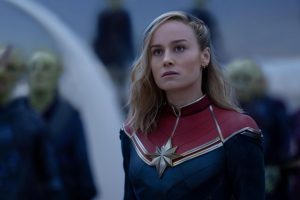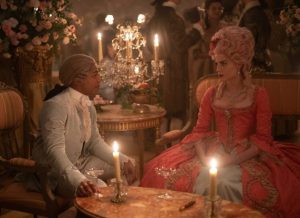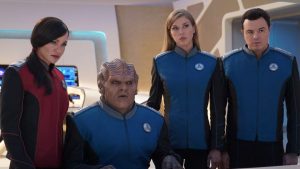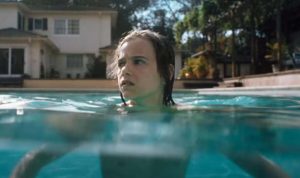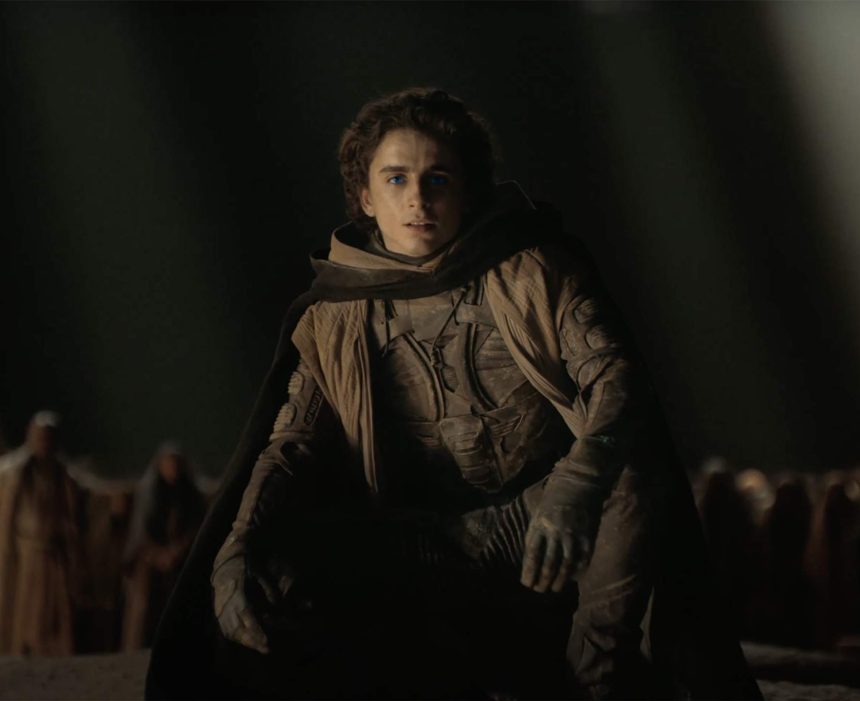
A GRAND SCI-FI VISUAL BLOCKBUSTER OF
A TRUE EPIC CINEMATIC EXPEREINCE
Beyond fear, destiny awaits! A future beyond our amazement and wonder, but is rooted in humanity, the evolution of mankind, the trappings of power, and the dangers of blind fanaticism. In 2021, moviegoers everywhere got to experience Dune, a sprawling and dense narrative driven film adaptation that’s based on author Frank Herbert’s beloved science fiction timeless classic. Directed by Denis Villeneuve, the film, which starred Timothee Chalamet, Zendaya, Rebecca Ferguson, Oscar Issac, Javier Bardem, Josh Brolin, Jason Momoa, and Stellan Skarsgard, is set in the far distant future and follows a young Paul Atreides as his family (the noble House Atreides) is thrust into war for the deadly inhospitable desert planet of Arrakis, unaware of a plotted scheming by their ancient rivals from House Harkonnen. Originally scheduled to be release in late 2020, Dune was delayed a full year due to the COVID-19 pandemic and received a theatrical release on October 22nd, 2021. The film was a box office success and grossed $402 million at the box office worldwide against its $165 million production budget. The movie itself was well-received from both critics and moviegoers alike, with many praising the feature for Villeneuve’s direction (and ambition), the screenplay, the visual effects, costume design, the musical score, cinematography, the ensembled cast, and the faithfulness to Herbert’s novel. In addition to being nominated and receiving numerous other accolades and awards, Dune went on to receive ten nominations at the 94th Academy Awards and won six of them. Following the film’s immediate success, it was quickly announced that planned sequel titled Dune: Part Two was to be greenlit and that mostly everyone on the project (director, cast, writer, and other key “behind the scenes” players) would be coming back for this second installment. Now, after three years since Dune, Warner Bros. Studios (and Legendary Pictures) and director Denis Villeneuve present the second half of his vision in Herbert’s novel with the release of Dune: Part Two. Does the movie rise above high expectations and complete the fully realized adaptation of popular sci-fi novel or is it a bloated endeavor that crumbles underneath a lofty vision of adapting one of the greatest science fiction stories ever told?
THE STORY
Following the Harkonnen attack on Arrakis, which saw the forces of Baron Vladmir Harkonnen (Stellan Skarsgard) seize control of the planet’s spice harvesting and overthrowing House Atreides’s stewardship, Paul Atreides (Timothee Chalamet), the lone survivor of his family’s name, has been adopted into the Fremen people, growing close with skilled warrior Chani (Zendaya), while leader Stilgar (Javier Bardem) watches the young man as he takes his first steps into the desert people’s lifestyle, culture, and the long-awaited prophecy that will bring prosperity to the planet. Adopting the name of Maud’dib, Paul’s popularity in the Fremen begins grows, which frightens Chani and gives notice to Stilgar’s motivations, while Paul’s mother, Lady Jessica (Rebecca Fergusons), follows her own precarious path in becoming a Reverend Mother, forcing the woman to face both revelations and consequences that she cannot stop. The Baron puts his faith into his nephew, Rabban (Dave Bautista) to lead House Harkonnen’s new dawn of spice production, but he’s unable to maintain control, with frequent Fremen attacks on harvesting and reserves resources. Looking to stamp out such troubles, the Baron brings in his other nephew, Feyd-Rautha (Austin Butler), a ruthless and cunning man, to do what Rabban is unable to, with the psychotic man delighting in his chance to take over Arrakis. Elsewhere, the Princess Irulan (Florence Pugh), daughter to Emperor Shaddam IV (Chrstopher Walken) draws concerns over the matter of control in Arrakis, hearing whispers of Maud’Dib’s rise to power amongst the Fremen, with her father unclear how to squash such a potential to rival his power. War and destiny goes hand-in-hand, drawing ever closer as all threads from both heroes and villains’ inch ever closer, tied to Paul’s decision to embrace the mesonic prophet, who wrestles between the warrior he hopes to be, and the messiah others want him to become. The fate of the galactic Imperium hangs in the balance and will be decided upon the coarse sands of Arrakis as a young man’s destiny will reach a climatic crossroads into an unknown future.
THE GOOD / THE BAD
Dreams are messages from the deep….and indeed they are. When it was first announced that a major Hollywood studio was going to be adapting Frank Herbert’s Dune was super excited and intrigued by the notion of such endeavor. Of course, as much as I had outlined of the previous iteration of Dune, the movie’s story is quite gripping, yet every dense and sophisticated. In the wrong hands, the movie could’ve been a disaster, losing its way on many challenges in undertaking and translating the material from page to screen. To me, the movie was going to one of great interest to watch….and not just because of the film demonstrating / understanding the source material, but to make a new cinematic experience from such an old and beloved literary property such as Dune. Of course, it goes without saying that my expectations were extremely high for this movie, and I can see that beyond a shadow of a doubt that were met and even succeeded them. 2021’s Dune was a visual stunning sci-fi masterpiece that was brought to life (and cinematically engineered) by one Denis Villeneuve’s grand vision for Herbert’s tale. The respect and undertaking of it all rest solely on his drive and passion for the source material and it certainly does come off that way while watching the movie. From the concept to worlding building aspect, I personally felt that Villeneuve was the best person to direct such a mammoth project like this and brought forth a beautifully dense movie that was highly entertaining and was welcome by both fans of the classic science fiction novel and casual moviegoers alike. I do also have to mention that the overall presentation for Dune was absolutely amazing from the art direction to score. Everything in the presentation category was dripping with style and pizzaz and gives the movie the necessary extra cinematic “oomph” to heighten a grand story. Plus, I as mentioned in my review for the movie, the film’s cast is almost like a “dream cast” selection, having some best possible acting talent to play these extraordinary characters. I mean Timothee Chalamet was perfect for the role of Paul…so was Rebecca Ferguson as Lady Jessica, and Oscar Issac as Duke Leto II. Even supporting roles from Bardem, Momoa, Zendaya, Skarsgard, Bautista, Brolin, and others were perfectly casted in their respective characters, each one portraying them with such great talent and screen presence that made each of them stand out effectively. Loved the entire cast. In the end, Denis Villeneuve’s Dune (even to this day) still stands as a grand vision of Herbert’s work, presenting a visually stunning cinematic masterpiece that’s breath-taking to watch, an awe-inspiring for a Hollywood blockbuster, and a faithful adaptation of the classic science fiction novel.
This brings me back to talking about Dune: Part Two, a 2024 sci-fi action epic drama and the follow-up sequel to 2021’s Dune. As mentioned, the conclusion of 2021’s Dune promises a sequel that would cover the second half of Herbert’s original novel, with Villeneuve hoping that a second movie would be greenlit in the near future. Given that success, Warner Bros / Legendary Pictures gave their blessings for that film, with Dune: Part Two set to go into production in 2022 and a tentative release set for late 2023. As I stated, Villeneuve would be returning to helm the project as well as most of the key “behind the scenes” players and the cast coming back to reprise their respective roles. Following this, hearing about the new cast members to play a part in Dune: Part Two (Pugh, Butler, Walken) got me really excited, especially hearing about the characters from the book that they were going to be playing. Then the movie’s trailers previews began to appear online, and in-theaters (during the “coming attractions” previews) and it looked amazing. It looked like an actual continuation of the movie, with a lot of the same style, flair, and presentation that the previous project had. Thus, a genuine continuation and it got me all excited. The scope looked grand and epic and since I knew I read the book and knew the story….my mind raced with all the scenes that this upcoming blockbuster film was going to potential present in such a cinematic way. So, it goes without saying that I was beyond excited for this project. Thus, I was upset when it was announced that Warner Bros. juggled around Dune: Part Two’s theatrical release date several times (original October 20th, 2023, then November 17th, 2023, and then to November 3rd, 2023) and then pushed it back for several month due to the writer / actor strike until the date of March 1st, 2024. Time passed and my overall anticipation for this project continued to swell. Before long, early / advance screenings began to take place and (once the embargo on the film was lifted) and speaking about how great the movie was, with many citing that Part Two is “visually stunning” or “beautifully epic”. This, of course, made me very excited and geeked out to actually see the movie. So, I went to see the movie during its opening night and feverously worked on getting my review done as soon as possible, which did take mee a bit longer than expected. And what did I think of it? Well, I loved it! Despite some few minor parts, Dune: Part Two is visually sci-fi masterpiece that continues and expands upon what Villeneuve established in the first film and propels Herbert’s tale of war and destiny in a stunning and cinematically drawn motion picture. Many have compared this movie to Empire Strikes Back or The Two Towers….and I would definitely have to agree with that!
As mentioned, Dune: Part Two is directed by Denis Villeneuve, the director behind such films as Arrival and Blade Runner 2049 and (of course) Dune. Given his familiarity of the previous Dune feature and with his express interest of wanting to do the sequel, Villeneuve is the perfect candidate to helm such a project. With such a clear vision as to what he began in the first Dune movie gives Villeneuve plenty of creativity breathing room to further continue / build upon the second half of his personal film adaptation of Herbert’s classic sci-fi novel. As to be expected, Dune: Part Two clocks in a whopping 166 minutes (two hours and forty-six minutes) in length, which may sound quite an exhausted and strenuous, but the movie honestly didn’t feel as long as it did, especially since the movie itself was quite engrossing. Of course, such extra time spent on this film was almost essential as Villeneuve had a lot of ground to cover in adapting Herbert’s novel, with writer Jon Spaihts (along with Villeneuve) writing the feature’s screenplay and “unpacking” the source material and presenting it all in way that’s both cinematic in feeling (framing it all in motion picture presentation) and informative. This marriage of these two works as Villeneuve / Spaihts present a movie is true continuation of the 2021 project, but also can kind of almost stand on its own merits without a viewer watching the first film. Such wrapping and navigating through such dense (and sometimes convoluted and thorny) material can be a daunting task, but the pair do a great job in the film’s world building aspect in presenting Herbert’s world with such vivid detail and depictions. This also extends to the storytelling aspect itself and further continues to push forward many of the characters established in the first film as well as introducing new players to the grand scheme of the plot. Such a firm hand at the helm is what is indeed for such a lofty and grandiose vision of movie and Villeneuve is absolutely incredible in managing and orchestrating such a bigger and more expansive project that he did in his previous Dune movie. Cinematically rendered in such intricacies and captivating moments help bolster Dune: Part Two, with Villeneuve’s passion seeping into every nook and cranky of the movie’s genetic make-up yet remaining levelheaded and confident in establishing a feature film that correct way.
Naturally, this brings up a lot of the film’s narrative and themes that Villeneuve wanted to convey from Herbert’s novel and the ramifications that he has on people. As some know out there, the story of Dune is filled with motifs, signs, and commentary messages on being a cautionary tale of people in power and the struggles that mankind faces throughout the course of history. Such lofty themes and ideas, despite being set within a sci-fi realm, can be extrapolated towards today’s world, with Dune’s story acting like a blueprint guide for what many have come across in society in both past, present, and future. While the first movie introduced several of those ideas, Dune: Part Two further cements those ideologies on a much darker and larger scale that move beyond such “black and white” cuts of greed and power. Such themes and social commentary messages like be wary of charismatic leaders, blind faith, religious fanaticism, and political society manipulation serve as the foundation of Dune: Part Two’s narrative, acting as viable source of caution and forewarning of what can be caused by this. Heroes might win the day and triumph over evil, but at what cost and is the “cause and effect” that has been unleashed due to the simple fact. The conclusion of movie’s plot leads us (as the viewer) to question such morals and scruple judgments that not every “ends justify the means”, with Villeneuve playing those themes in the film’s backdrop. As the lines whispered to Paul in the movie “You are not prepared for what is to come” is exactly what Herbert wanted to convey in his story of war and destiny, creating a ripple effect throughout the rest of the narrative that’s good and bad at the same time.
Of course, Dune: Part Two isn’t all about the drama dynamics and thematic commentary folds of storytelling, with Villeneuve amping up the film’s action scenes to a blockbuster style level, which helps elevate the tension and excitement of the overall feature. While the first film drew a bit of criticism for its lack of action moments, this film delivers on that promise for large scale sequences of battles and action, which is quite enticing on the big screen. The staging, choregraphing, and overall execution of such sequences is amazing to see on everything is planned out and its true testament and talent to see Villeneuve orchestrate such intense moments of action that surely please not just sci-fans out there, but also causal moviegoers who are looking for cinematic action on a grand scale. I know that I should mention this particular aspect in my presentation portion of my review, but I do have to talk about the visual effect for the movie. The overall praising of Villeneuve’s direction for the usage of practical effect is quite palpable as the film itself is fascinating to see the level of detail that visual appeal and nuances that are felt in very practical ways. That being said, the visual effects shots, especially the ones that are used in the film’s actions sequences, are quite amazing and jaw-dropping to behold. From a destroying a massive spice harvester to several giant sandworms attacking Imperial / Harkonen forces, those moments are pure cinematic spectacle at their finest and are truly a sight to behold. Thus, this gives the movie that certain height within its blockbuster flair of large scale without sacrificing the source material’s narrative nor Villeneuve ultimate vision for the project, which is always a great thing. In the end, there is simply no denying the fact that Villeneuve’s direction and ultimate vision for this movie is so prolific and profound; making Dune: Part Two almost like his “magnus opus” in the level of carry and attention that he brings to project, which results in a sprawling and brilliance realized second half of his epic film adaptation of Frank Herbert’s timeless sci-fi classic.
There is no mistaking that Villeneuve’s vision for the Dune saga, with the first movie showcasing the epic and heightened cinematics drama within the feature’s presentation to fully propel a grand and theatrical bold creation of Herbert’s vivid sci-fi world in a modern-day motion picture. In Dune: Part Two’s presentation…. that same type of carry for attention, detail, and cinematic flair is felt once again within the context of the project and actual amps up the level of heightened dramatics for some outstanding and gorgeous film landscape that helps brings this futuristic world to life. As in before, the movie’s setting is almost like a secondary character throughout the entire movie, with the backdrop of a desert planet illustrating some profound set designs and locations that feel organically real and not just movie sets. Everything has that grandiose feeling and otherworldly, yet still feels familiar and has as based on humanity within the various places, buildings, and architecture. It’s a level of detail that Villeneuve usually has throughout most of his projects and is clearly felt in this movie, expanding on the knowledge and film interpretation of what the first movie was able to present and build upon that. Even the costume designs from all the various characters are well-drawn out with great detail and intricate authenticity that clearly have a certain type of rooted fashion (style and aesthetics) of real world culture and time period, but also have a peculiar strangeness to them that feels very fantastical and almost sci-fi-ish foreign, which does add that extra layer of quality rather than just making “generic” sci-fi wardrobe attire for most of his characters. Thus, many of the film’s “behind the scenes” players (most who worked on the first Dune movie), including Patrice Vermette, Zsuzsanna Sipos and Shane Vieau (set decorations), Jacqueline West (costume designs) as well as the entire hair / make-up team, and the art direction department, should be highly praised for their creative involvement on this particular film and how (along with Villeneuve) help bring this movie’s world to life with such great characteristics, which (again) like a character unto itself.
What definitely brings all those set locations, costume outfits, and interstellar futuristic decorum to life is the usage of cinematography and amazing and fantastic imagery that cinematographer Greig Fraser. Like his work on the first Dune movie, Fraser’s techniques, finesse, and ultimate workings as director of photography is astounding ana incredible to watch. Villeneuve’s movies have always utilized such heightened and dynamic camera angles and shots as well as Fraser’s contribution to some of his popular projects like Rogue One: A Star Wars Story, The Batman, and The Creator. Thus, this collaboration between the two men truly does speaks “theatrical volumes”, especially with Dune. In Dune: Part Two, Fraser’s work is once again beautifully stellar and amazing to look it, cultivating many (and I do mean many) awe-inspiring and jaw-dropping scenes that are so epic in scale and cinematic presentation that is quite literally a visual feast for the eyes. The utilization wide angle shots to the effectiveness of shadowing and lighting, every one of these sequences is mesmerizing to watch and (as I stated many times already in this review) heightens the feature’s cinematic to a whole new level…. even more so than what Fraser was able to accomplish in the first Dune film. The whole black and white contrast scenes on Giedi Prime (during Feyd’s introduction) was incredible. Awesome job from Fraser’s techniques throughout the entire Dune: Part Two presentation…. simply movie magic at its best.
Coinciding with that notion, Dune: Part Two’s sound design (editing and mixing) is top notch and definitely heightens the movie’s level of soundscape for a theatrical motion picture. I usually don’t mention the sound design unless I do feel that its necessary to bring up, but for this movie…. it’s definitely worth mention. The sound design for 2021’s Dune was amazing and deserves a lot praise and accolades that us cinephiles love in a grand film endeavor of large-scale scope and grandeur. Dune: Part Two follows in those same cinematic veins and drive home some unbelievable sound design for the movie that definitely intensifies many of the scenes that heavily imply such soundscape making of high-power explosions and dynamic action fight scenes. Just purely magic to the ears.
Lastly, the film’s score, which was composed by Hans Zimmer, is truly one of his best film soundtracks to date. Like many within this category, Zimmer previously did the scoring for 2021’s Dune and demonstrated his love and passion for Herbert’s work by creating a movie soundtrack that has very distinct and unique sound within its musical composition; generating an almost alien and unfamiliar pieces that were very grand and bombastic, which spoke to the movie itself. Once again, Zimmer returns to Villeneuve’s cinematic world of Dune in Dune: Part Two and absolutely nails it beautifully. Many of the themes and musical motifs that Zimmer created in the first movie return and continue to play a vital and instrumental role in the story, but he also expands upon them in a very interesting way that helps build upon the foundation of film’s narrative and overall presentation. Thus, to hear them all again…in new ways….is amazing. Plus, Zimmer creates several new themes for this sequel and the one that nails it definitely out of the work is the new love theme between Paul and Chani. I think on the official original soundtrack listing it’s called “A Time of Quiet Between the Storms”. It’s heard several times throughout the project and even in the movie’s final movie trailer and its superb and impactful, which cultivates the cinematic weight that Zimmer wanted to create as well as Villeneuve’s grandiose scope for Herbert’s world. All in all, Zimmer’s score for Dune: Part Two is hands down a “must listen” for movie soundtrack lovers and delivers a stunning composition that exceeds even my expectations.
As much as I fully enjoyed this movie, I felt that Dune: Part Two had one or two missteps along the way that, while not derailing the movie in any way, shape, or form, made me like 2021’s Dune a little bit more than this one. How so? Well, for starters, the pacing of the movie is a bit off at times. In the first film, the overall flow of the feature was very steady and firm, even when the film’s story cut away to other narrative subplot threads and characters. In truth, Dune had a good overall flow and within its pacing. For Dune: Part Two, there is a lot to digest and to explore and the movie’s extra-long runtime does certainly benefit for examining such details, but the overall flow and pacing of the feature gets a bit messy in a few key areas. The movie is definitely engaging and almost every scene is cinematically beautifully realized, but I felt that the pacing of the story in the film isn’t quite as ironed out as it could be. Because of this certain characters (old and new ones) gets pushed more the backburner in favor of other ones and particular storytelling bits from the plot being altered and / or removed entirely. This isn’t a complete “deal breaker” for me, but it just felt like this could’ve been ironed a little bit more in the overall editing and piece together of the feature.
In conjunction with that idea, there were a few parts of the movie that were a bit “hurried” and / or “rushed”, despite the significance to the movie’s story or some character motivations that were being built up throughout the course of film. Similar to what I mentioned above…. certain aspects are drawn out and presented in the movie that don’t exactly have the same palpable resolution and / or follow through of what I was expecting. This is most notable in the third act of the movie, with the film’s climax was building upon and reaching its epic action. There are a lot of moving parts and, while I do give kudos to Villeneuve and the film editors for piecing everything together, the latter half of feature still a bit rushed, which is quite strange, especially when considering the lengthy runtime Dune: Part Two has. Thus, certain elements, characters, and scenes are semi-glossed over in a hurried manner Again, a more of a minor nitpick and not at all as a deal breaker by any means necessary, but just something that could’ve been tweaked in the movie’s shaping and overall execution.
As was before the first Dune movie, the cast of Dune: Part Two is incredible and almost feels like a “dream cast”, with the ensemble of actor and actresses picked to play these fictional characters lend so much weight and depth. All of the cast members deliver some great performances in the movie and are either fleshed out further from the first one or have enough screen presence to make their roles in the film memorable, despite some having limited screen time. Leading the charge of the film’s cast is actor Timothee Chalamet, who plays the central protagonist character of Paul Atreides. Known for his roles in Little Women, Wonka, and Call Me by Your Name, Chalamet has slowly becoming a more household name with general moviegoers, rising in popularity and gaining more prominent lead character roles in his career. Thus, his performance in 2021’s Dune was a great one and showcased that Chalamet had the acting experience and the gravitas to play such a meaty role as the character of Paul Atreides. In Dune: Part Two, Chalamet doesn’t miss a beat and his continues to show his acting chops in further playing the character of Paul in the movie, showcasing the heir apparent to his late-father’s name façade as he begins his journey to be adopted into the Fremen culture as well as inching closer towards his ultimate destiny…. whether he wants to or not. While it may be written almost like the classic “hero’s journey”, the character of Paul Atreides definitely draws debates on whether or not he is a good or bad guy. The movie’s script does wrestle with the concept in a few key areas, with Paul conflicted about whether or not he should choose to embrace his destiny and become what the Bene Gesserit engineered for centuries or let the Fremen people perish underneath the Harkonen forces. In these darker tones and thoughts where Chalamet does a great job in walking a fine line those sequences and really demonstrating the weight and screen presence that he has during those scenes. He’s a character that you root for, but linger doubts as to what he will be become when the main threat is over, which is what Herbert intended for the part. Thus, Chalamet is absolutely incredible once again in playing Paul Atreides (or rather Maud’ Dib) in a juicy and meaty character role that has to be one of his best portrayals of his career.
Behind the title character of Paul, Dune: Part Two gives actress Zendaya a new opening with her character of Chani, a young female Fremen warrior who takes an interest / relationship with Atreides man, the chance to take centerstage throughout the movie and gives her plenty of depth within her narrative. While mostly presented in dream-like visions sequences and a brief appearance during the final twenty minutes of the first Dune, the character of Chani gets the chance have a larger spotlight focused on her as Zendaya, who is known for her roles in Euphoria, The Greatest Showman, and Spider-Man: No Way Home, is up to the task in making her mark on the feature / franchise with such tenacity and screen presence throughout. Her portrayal of Chani is one of great interest, especially when examining how much she plays a vital role in the movie’s narrative and how she plays a part in the character of Paul’s love interest. She’s fiercely loyal to her people and to culture that the Fremen represent to the desert / planet and will do anything to fight to save them from the tyranny of the outworlder oppressors. Perhaps the most interesting aspect that the movie does is (as mentioned above) is to give Chani something more to do and is given a deeper personality. Of course, the romance angle in their relationship was almost a given and to be expected for this story, but, in Dune: Part Two, the movie gives her a platform as to almost “go against” the lisan al gaib prophecy, non-believing in the myths of Paul’s power and what it means for her people (Fremen). It’s an interesting angle, especially when comparing her character to Stilgar (a believer), as it gives Chani more character depth and more well-roundness towards Paul, Jessica, and how plot that unravels in the movie. In addition, I felt that both Zendaya and Chalamet have some great on-screen chemistry with each other, which definitely is a easy way for us (as the viewers) to buy into their blossoming relationship. So, I thought that Zendaya is a great job in the film and gave the character of Chani a good dose of insight characteristic to make her perhaps the most compelling (and interesting) portrayal in the various Dune adaptations that have come before.
In more supporting roles to both Paul and Chani, the characters of Lady Jessica, Paul’s mother, and Stilgar, leader of the Fremen Stietch Tabr / mentor to Paul, are solid in their representation and involvement in Part Two’s narrative and are once again played by actress Rebecca Ferguson (The Greatest Showman and Mission Impossible: Dead Reckoning) and actor Javier Bardem (No Country for Old Men and Skyfall) respectfully. Ferguson is quite the capable actress and has started to appear more and more in prominent roles and projects of late. Her involvement in the first Dune movie was fantastic, showcasing Jessica as a women who is caught between being a parent to her son (Paul), a lover to Duke Leto Atreides, and as a sister of the Bene Gesserit. This, of course, presented a character who was conflicted and showing the steadfastness mask she puts on display (in front of everyone) and vulnerable when she’s by herself. Dune: Part Two propels the character of Jessica forward, with Ferguson leading the charge in such a juicy / meat role throughout the movie. The fragileness of Jessica is gone as the character goes through a change, one that puts a new darker twist. The machination that she goes through and how she began to weaves mythmaking of Paul’s destiny to the Fremen is something quite underlining sinister as Jessica (like her son) goes through a metamorphosis to reach her full potential. It’s quite fascinating to behold and perhaps the most darkest portrayal of the character in all the film adaptations of Dune. Plus, it’s clear that Ferguson is enjoying playing the role and is quite magnetic in almost every scene she is in and whoever she is acting with therein. Like Ferguson, Bardem is another character that was a perfect fit for the role of Stilgar, a character who is deeply passionate about his people (Fremen), as the actor brings the right amount of screen presence to make the role believable and memorable. Such a portrayal in the first movie was minor supporting player, which was due to the narrative framing of the feature (mostly towards the end of the film), but Dune: Part Two, the character of Stilgar has a lot more to do and is giving a heftier screen time in the movie, with Bardem continuing to demonstrate a great character role throughout. It is quite interesting to see Stilgar, a man who is steadfast and clearly defining his faith, goes a little bit “religious zealot” throughout the course of the movie as he witnesses the rise of Paul Maud’ Dib’s power in the “lisan al gaib” prophecy. It’s a bit comical (in a way) to see him go into zealot mode as what he witness (and deems) as miracles from Paul as the mesonic figure of destiny to the Fremen, which I can see a bit of annoying to some, but I felt it was part of Villeneuve’s vision for the character. Still, Bardem continues to be quite effective as Stilgar and does leave the door open for such a character to have some great internal conflicts within in the future Dune movies. Overall, both Ferugson and Bardem deliver some solid larger supporting roles in the film and gave some great context and insight that the story of Dune: Part Two has to offer.
As for the bad guys, Dune: Part Two sees the return of main players of House Harkonnen in the characters of the Baron Vladmir Harkonnen and his nephew Glossu “The Beast” Rabban, who are once again played by actors Stellan Skarsgard (Good Will Hunting and The Girl with the Dragon Tattoo) and former wrestler / actor Dave Bautista (Guardians of the Galaxy and Glass Onion: A Knives Out Mystery). For his part, Skarsgard continues to demonstrate such a deliciously evil portrayal of the Baron in such sinister way, which (as mentioned in my previous review for Dune) is more accurate to how Herbert wrote the character in the books. The massive and grotesque body into conjunction with despicable and cunning machination mind that he has, Skarsgard is the perfect embodiment of Baron Harkonnen and continues to demonstrate a terrific performance in a bad guy. Similarly, Bautista continues to show the frustration and feverously ruthlessness mindset that Rabban as he pressures the Harkonnen armies to mine / harvest the spice for his family while also fighting off against Maud ’dib’s rebel resistance attacks. In addition, I do like the idea, Dune: Part Two does give more screen-time to Bautista than in the previous film and, while it doesn’t radically change his character, the more allotted screentime to see his portrayal of Rabban on-screen is very much appreciated.
Naturally, Dune: Part Two does offer some new characters to come aboard the project and are allotted screen time to make their presence known on the movie and the story being told in Herbert’s sci-fi world. Who probably makes the most lasting impact in the movie would be actor Austin Butler (Elvis and Masters of the Air) who plays the character of Feyd-Rautha, Baron Harkonnen’s other nephew. While Bautista’s Rabban is more brutish and blunt, Butler’s Feyd is more cold and calculating, almost like a viper who is ready to strike. Plus, the character in the movie is quite creepy and has all the right ticks of a psychopath, which does make for an interesting villain. While Butler has always played the handsome / good looking guy in a lot of his roles, it was nice to see him play such a vile character, which he probably had a lot of fun doing and it shows that on-screen. Plus, it was also good to see him lose that Texas / American sounding drawl in his voice that he has utilized in a lot of his recent production since Elvis. Perhaps the only slight disappointment for me is that the character of Feyd-Rautha is that there isn’t a whole lot of time devoted in the film for him. The script sets him up to be quite a formidable figure for Paul and his companions to overcome, but that’s pretty much it. Basically, the character serves the purpose of the plot (and the movie) as the “darker half” of what Paul could become….and that’s it. However, that was partially the problem with the character in the book, so doesn’t bother me as much. Just looking at the film objectively. Still, Butler was indeed quite memorable in the role of Feyd-Rautha, a menacing and frightening individual that certainly knows how to make an impact on almost every scene he’s in. Great job!
The same can be said with the other two notable characters from House Corrino, which comes in the form of Emperor Shaddam IV, the Padishah Emperor of the Imperium, and his daughter, Princess Irulan, who are played by actor Christopher Walken (Hairspray and Wedding Crashers) and Florence Pugh (Little Women and Oppenheimer). To be fair, I was with the main group of people who was a little bit cautious / leery when it was first announced that Walken was cast to play Shaddam IV in Dune: Part Two, especially playing such an important (yet supportive) character in Herbert’s novel. Plus, I felt that Walken was probably gonna play the role with his usually “Walken” schtick in voice, mannerisms, and performance. However, that is not the case in the movie and Walken does quite a surprisingly subbed portrayal of Shaddam IV that’s more grounded rather than bombastic. It does show the character (how he was written) to be more of an indecisive leader in his motives and understanding, which is a bit of a departure from how I pictured the great “Padishah Emperor” would be, but it does fit nicely within Villeneuve’s vision for Dune. I do wish that there were a bit more scenes with Shaddam IV and would’ve be beneficial to see what Walken does with the character, but, for what it’s worth, he was quite effective in the role. Likewise, Pugh’s Irulan is pretty good in the movie and carries the proper weight, grace, and gravitas as one would expect from an intergalactic (and scholarly) princess would in this fictional sci-fi universe. Like Herbert’s novel, the character doesn’t really have much to do in the movie beyond questioning whispers and rumors of what is going on Arrakis to her elders and peers, which is clear representation of what probably Herbert intended Irulan to be. However, I am excited to see what becomes of Irulan in the Dune: Part Three (assuming it does get greenlit) and what Pugh does with the character, especially since I know what her character plotting in the next two books.
As a little sidenote to these three characters, I think it would been beneficial Villeneuve’s Dune (Part One and Two) if they (Feyd-Rautha, Shaddam IV, and Irulan) were featured in the first movie in some small way rather than just being pushed back to the second half. I understand why Villeneuve decided to do it, especially since in Herbert’s novel that these characters are introduced in the latter half of the story, but I felt that he could’ve incorporated them a bit (or simply introduce them) in the first feature film and able to expand upon them in Part Two. Again, that’s just me.
The other notable addition in the movie would have to actress Lea Seydoux (No Time to Die and Midnight in Paris), who plays the character of Lady Margot Fenring, a member of the Emperor’s Imperial Court and a sister of the Bene Gesserit order. While her character is mostly a minor one in the film’s grand scheme of things, she does play a vital (yet small) role during Feyd-Rautha’s introduction and provide a better understanding / context to what position that the Bene Gesserit order have on all the great houses of the Imperium. In addition, Seydoux’s performance as Lady Margot Fenring is devilishly fun to watch and it’s quite clear that she has having fun playing such a character. It would’ve been nice to see more of her in the film, but, for the sum parts she’s in, Seydoux is quite electrifying in the role.
Other supporting players, including actress Souhelia Yacoub (The Braves and Climax) as Fremen warrior Shishakli, actress Alison Halstead (Cyberpunk 2077 and Citadel) as the Maker Keeper, actor Babs Olusanmokun (The Widow and Wrath of Man) reprising his Dune role as Jamis, actor Roger Yuan (Bulletproof Monk and Shanghai Noon) reprising his Dune role as Lieutenant Lanville, actress Giusi Merli (The Great Beauty and Love Wedding Repeat) as Revend Mother Ramallo, and actress Charlotte Rampling (Broadchurch and Melancholia) reprising her Dune Role as the Reverend Mother Gaius Helen Mohiam, round out the remaining minor supportive characters in the movie. While some of these players only have a few scenes (ranging from one or two to a handful), the acting talents behind these characters are still highly effective and make for some compelling (yet small) roles in Dune: Part Two.
FINAL THOUGHTS
History is written on the sands of Arrakis as Paul Atreides and his mother (Lady Jessica) assimilate into Fremen culture, battle back against the Harkonnen forces, and draw ever closer towards a destiny that will shape the very foundation of the Imperium into an unknown future in the movie Dune: Part Two. Director Denis Villeneuve’s latest film is the second chapter in his film adaptation of Frank Herbert’s Dune novel, expanding upon the tale he began with 2021’s Dune and presentation of feature that is sprawling with visual imagery and a grandiose vision for an epic sci-fi story of grand cinematic proportions. Building upon what he learned from the previous installment, Villeneuve propels forward, drumming up heightened action, drama, and cinematography for a stunning motion picture event that’s worth sequel. While a few minor aspects are slightly mismanaged in continuation with a few ideas that are a tad hurried, a great majority of the film rises above expectations and delivers a powerhouse second half of the Dune’s saga, with special thanks from Villeneuve’s direction and overall grand vision for the project, a very layered story of morals and themes, fantastic action sequences, an incredible (extremely large emphasis) presentation, beautiful cinematography, absolutely dramatic and epic score from Zimmer, a continued “dream cast” collection of acting talents, and very meaty characters portray throughout the film. Personally, I loved this movie immensely. It definitely felt like the feature was a genuine continuation of the first film, expanding the narrative and showcasing a very magnificent and cinematic experience that could easily rival any current studio blockbuster tentpole, without sacrificing the integrity of Herbert’s prolithic source material. It’s that good…. plain and simple. Is Dune: Part Two better than its first half? Well, it depends on what you look at. For its scope and scale…. I believe that Part Two is better. However, Dune had a better flow and pacing. So, it’s a tossup to me, but both movie are equally memorable and highly entertaining….making up the two halves of an incredible cinematic adventure. Thus, one can easily surmise that my recommendation for this movie is most definite “highly recommended” as it’s a film that is worth the hype and anticipation that the sequel has been receiving and should please longtime fans of classic sci-fi novel as well as casual moviegoers that are looking for a really great theatrical motion picture to watch. The ending of Dune: Part Two promises more in this sprawling epic saga, with Villeneuve expressing interest in Dune: Part Three, which would cover Herbert’s second Dune novel titled Dune Messiah. Will this next entry be greenlit? All roads and signs point to yes, so here’s to hoping that WB / Legendary give the go ahead in the near future. Can’t wait to see how Villeneuve presents Dune Messiah’s story and how he ultimately concludes his Dune trilogy. For now, Dune: Part Two stands as a crowning achievement for Villeneuve as a beautifully crafted and a cinematically epic sci-fi tale experience of war and destiny and how each one goes hand-in-hand with each other. The voice from the Outer World has come, the Kwisatz Haderach has awakened, and the saga of Dune is far from over….
4.9 Out of 5 (Highly Recommended)
Released On: March 1st, 2024
Reviewed On: March 7th, 2024
Dune: Part Two is 166 minutes long and is rated PG-13 for strong violence, some suggestive material, and brief strong language
The post Dune: Part Two (2024) Review appeared first on Jason’s Movie Blog.

